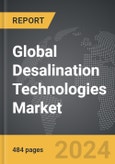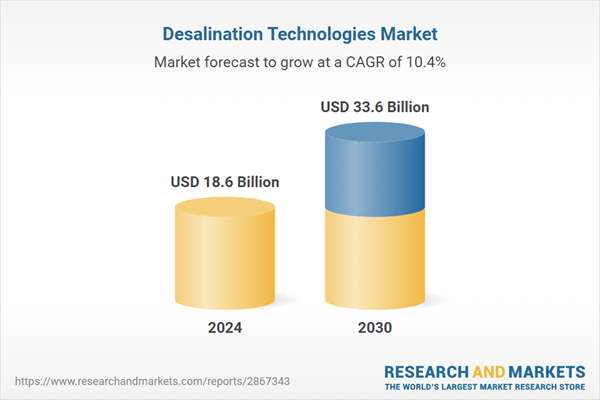The global market for Desalination Technologies was valued at US$18.6 Billion in 2024 and is projected to reach US$33.6 Billion by 2030, growing at a CAGR of 10.4% from 2024 to 2030. This comprehensive report provides an in-depth analysis of market trends, drivers, and forecasts, helping you make informed business decisions. The report includes the most recent global tariff developments and how they impact the Desalination Technologies market.
The desalination industry has seen significant technological advancements aimed at improving efficiency, reducing costs, and minimizing environmental impact. Innovations such as energy recovery devices, advanced membrane materials, and hybrid desalination systems have enhanced the performance and sustainability of desalination plants. For example, energy recovery devices in RO systems can capture and reuse energy from the high-pressure brine stream, significantly reducing overall energy consumption. Additionally, new membrane materials with improved permeability and resistance to fouling extend the lifespan of RO systems and lower operational costs. Hybrid systems that combine RO with thermal processes or renewable energy sources like solar and wind power are also being developed to further reduce the environmental footprint and operational costs of desalination. These advancements are crucial in making desalination a viable option for an increasing number of regions worldwide.
The growth in the desalination technologies market is driven by several factors, including rising water scarcity, technological advancements, and supportive government policies. Increasing populations, urbanization, and industrial activities are escalating the demand for freshwater, particularly in arid and semi-arid regions. Technological innovations are making desalination more efficient and cost-effective, encouraging its adoption. Governments worldwide are also recognizing the importance of desalination in securing water supplies, leading to increased investments and favorable regulations. For instance, regions like the Middle East, North Africa, and parts of Asia are heavily investing in desalination infrastructure to address their chronic water shortages. Additionally, the integration of desalination with renewable energy sources is gaining traction, driven by the dual need to address water and energy sustainability. As these factors converge, the desalination market is poised for significant growth, driven by technological advancements, escalating demand for freshwater, and proactive government initiatives.
Segments: Technology (Reverse Osmosis (RO), Multi-Stage Flash (MSF), Multi-Effect Distillation (MED), Other Technologies); Application (Municipal, Industrial, Other Applications).
Geographic Regions/Countries: World; USA; Canada; Japan; China; Europe; France; Germany; Italy; UK; Spain; Russia; Rest of Europe; Asia-Pacific; Australia; India; South Korea; Rest of Asia-Pacific; Latin America; Argentina; Brazil; Mexico; Rest of Latin America; Middle East; Iran; Israel; Saudi Arabia; UAE; Rest of Middle East; Africa.
The analysts continuously track trade developments worldwide, drawing insights from leading global economists and over 200 industry and policy institutions, including think tanks, trade organizations, and national economic advisory bodies. This intelligence is integrated into forecasting models to provide timely, data-driven analysis of emerging risks and opportunities.
Global Desalination Technologies Market - Key Trends & Drivers Summarized
Desalination technologies have become critical solutions for addressing the growing global demand for freshwater in regions facing water scarcity. These technologies work by removing salts and other impurities from seawater or brackish water, producing potable water suitable for drinking, irrigation, and industrial use. The most widely used desalination processes are reverse osmosis (RO) and thermal distillation. Reverse osmosis involves forcing water through a semipermeable membrane that filters out salts and contaminants. This method is favored for its energy efficiency and ability to produce high-quality water. Thermal distillation, on the other hand, involves heating water to create steam, which is then condensed back into liquid form, leaving salts behind. This process includes variations like multi-stage flash distillation (MSF) and multi-effect distillation (MED), which are highly effective but generally more energy-intensive than RO.The desalination industry has seen significant technological advancements aimed at improving efficiency, reducing costs, and minimizing environmental impact. Innovations such as energy recovery devices, advanced membrane materials, and hybrid desalination systems have enhanced the performance and sustainability of desalination plants. For example, energy recovery devices in RO systems can capture and reuse energy from the high-pressure brine stream, significantly reducing overall energy consumption. Additionally, new membrane materials with improved permeability and resistance to fouling extend the lifespan of RO systems and lower operational costs. Hybrid systems that combine RO with thermal processes or renewable energy sources like solar and wind power are also being developed to further reduce the environmental footprint and operational costs of desalination. These advancements are crucial in making desalination a viable option for an increasing number of regions worldwide.
The growth in the desalination technologies market is driven by several factors, including rising water scarcity, technological advancements, and supportive government policies. Increasing populations, urbanization, and industrial activities are escalating the demand for freshwater, particularly in arid and semi-arid regions. Technological innovations are making desalination more efficient and cost-effective, encouraging its adoption. Governments worldwide are also recognizing the importance of desalination in securing water supplies, leading to increased investments and favorable regulations. For instance, regions like the Middle East, North Africa, and parts of Asia are heavily investing in desalination infrastructure to address their chronic water shortages. Additionally, the integration of desalination with renewable energy sources is gaining traction, driven by the dual need to address water and energy sustainability. As these factors converge, the desalination market is poised for significant growth, driven by technological advancements, escalating demand for freshwater, and proactive government initiatives.
Report Scope
The report analyzes the Desalination Technologies market, presented in terms of units. The analysis covers the key segments and geographic regions outlined below.Segments: Technology (Reverse Osmosis (RO), Multi-Stage Flash (MSF), Multi-Effect Distillation (MED), Other Technologies); Application (Municipal, Industrial, Other Applications).
Geographic Regions/Countries: World; USA; Canada; Japan; China; Europe; France; Germany; Italy; UK; Spain; Russia; Rest of Europe; Asia-Pacific; Australia; India; South Korea; Rest of Asia-Pacific; Latin America; Argentina; Brazil; Mexico; Rest of Latin America; Middle East; Iran; Israel; Saudi Arabia; UAE; Rest of Middle East; Africa.
Key Insights:
- Market Growth: Understand the significant growth trajectory of the Municipal segment, which is expected to reach US$16.6 Billion by 2030 with a CAGR of a 10.1%. The Industrial segment is also set to grow at 11.3% CAGR over the analysis period.
- Regional Analysis: Gain insights into the U.S. market, valued at $2.1 Billion in 2024, and China, forecasted to grow at an impressive 11.3% CAGR to reach $3.6 Billion by 2030. Discover growth trends in other key regions, including Japan, Canada, Germany, and the Asia-Pacific.
Why You Should Buy This Report:
- Detailed Market Analysis: Access a thorough analysis of the Global Desalination Technologies Market, covering all major geographic regions and market segments.
- Competitive Insights: Get an overview of the competitive landscape, including the market presence of major players across different geographies.
- Future Trends and Drivers: Understand the key trends and drivers shaping the future of the Global Desalination Technologies Market.
- Actionable Insights: Benefit from actionable insights that can help you identify new revenue opportunities and make strategic business decisions.
Key Questions Answered:
- How is the Global Desalination Technologies Market expected to evolve by 2030?
- What are the main drivers and restraints affecting the market?
- Which market segments will grow the most over the forecast period?
- How will market shares for different regions and segments change by 2030?
- Who are the leading players in the market, and what are their prospects?
Report Features:
- Comprehensive Market Data: Independent analysis of annual sales and market forecasts in US$ Million from 2024 to 2030.
- In-Depth Regional Analysis: Detailed insights into key markets, including the U.S., China, Japan, Canada, Europe, Asia-Pacific, Latin America, Middle East, and Africa.
- Company Profiles: Coverage of players such as DuPont de Nemours, Inc., Hitachi Ltd., Doosan Heavy Industries & Construction Co., Ltd., Danfoss A/S, Evoqua Water Technologies LLC and more.
- Complimentary Updates: Receive free report updates for one year to keep you informed of the latest market developments.
Some of the 63 companies featured in this Desalination Technologies market report include:
- DuPont de Nemours, Inc.
- Hitachi Ltd.
- Doosan Heavy Industries & Construction Co., Ltd.
- Danfoss A/S
- Evoqua Water Technologies LLC
- Hitachi Zosen Corporation
- Aquatech International LLC
- IDE Technologies
- BWT AG
- Keppel Offshore & Marine Ltd
- AMPAC USA
- Aqualyng
- Keppel Seghers Pte Ltd
- Komax Systems Inc.
- Abengoa SA
Tariff Impact Analysis: Key Insights for 2025
Global tariff negotiations across 180+ countries are reshaping supply chains, costs, and competitiveness. This report reflects the latest developments as of April 2025 and incorporates forward-looking insights into the market outlook.The analysts continuously track trade developments worldwide, drawing insights from leading global economists and over 200 industry and policy institutions, including think tanks, trade organizations, and national economic advisory bodies. This intelligence is integrated into forecasting models to provide timely, data-driven analysis of emerging risks and opportunities.
What’s Included in This Edition:
- Tariff-adjusted market forecasts by region and segment
- Analysis of cost and supply chain implications by sourcing and trade exposure
- Strategic insights into geographic shifts
Buyers receive a free July 2025 update with:
- Finalized tariff impacts and new trade agreement effects
- Updated projections reflecting global sourcing and cost shifts
- Expanded country-specific coverage across the industry
Table of Contents
I. METHODOLOGYII. EXECUTIVE SUMMARY2. FOCUS ON SELECT PLAYERSIII. MARKET ANALYSISCANADAITALYSPAINRUSSIAREST OF EUROPESOUTH KOREAREST OF ASIA-PACIFICARGENTINABRAZILMEXICOREST OF LATIN AMERICAIRANISRAELIV. COMPETITION
1. MARKET OVERVIEW
3. MARKET TRENDS & DRIVERS
4. GLOBAL MARKET PERSPECTIVE
UNITED STATES
JAPAN
CHINA
EUROPE
FRANCE
GERMANY
UNITED KINGDOM
ASIA-PACIFIC
AUSTRALIA
INDIA
LATIN AMERICA
MIDDLE EAST
SAUDI ARABIA
UNITED ARAB EMIRATES
REST OF MIDDLE EAST
AFRICA
Companies Mentioned (Partial List)
A selection of companies mentioned in this report includes, but is not limited to:
- DuPont de Nemours, Inc.
- Hitachi Ltd.
- Doosan Heavy Industries & Construction Co., Ltd.
- Danfoss A/S
- Evoqua Water Technologies LLC
- Hitachi Zosen Corporation
- Aquatech International LLC
- IDE Technologies
- BWT AG
- Keppel Offshore & Marine Ltd
- AMPAC USA
- Aqualyng
- Keppel Seghers Pte Ltd
- Komax Systems Inc.
- Abengoa SA
Table Information
| Report Attribute | Details |
|---|---|
| No. of Pages | 484 |
| Published | April 2025 |
| Forecast Period | 2024 - 2030 |
| Estimated Market Value ( USD | $ 18.6 Billion |
| Forecasted Market Value ( USD | $ 33.6 Billion |
| Compound Annual Growth Rate | 10.4% |
| Regions Covered | Global |









